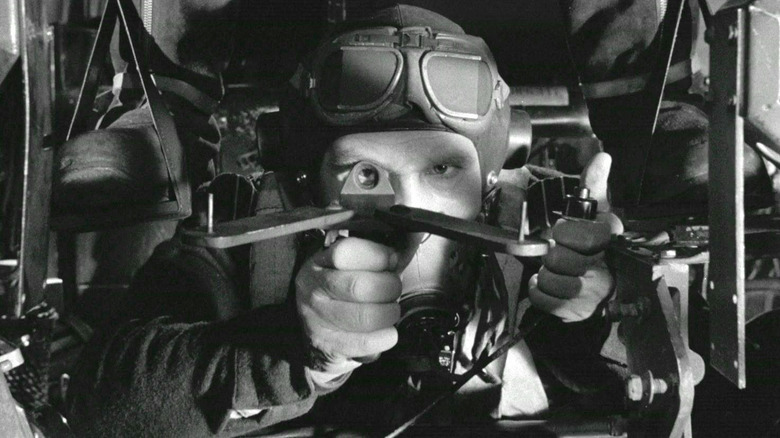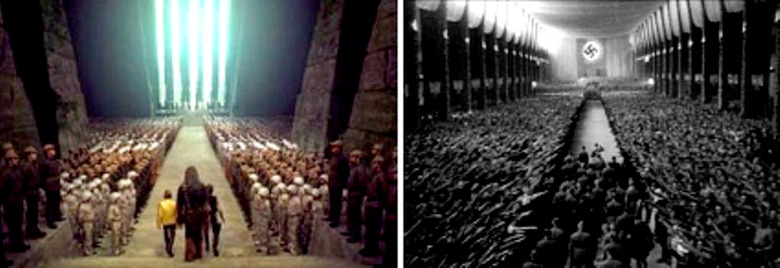How The World War II Drama 'The Dam Busters' Influenced The Space Battles Of 'Star Wars: A New Hope'
(Welcome to The Movies That Made Star Wars, a series where we explore the films that inspired George Lucas' iconic universe. In this edition: the British World War II drama The Dam Busters)
When George Lucas set out to make the original Star Wars film, there were things he wanted to do on film with special effects that had never really been done before. At least not on the level Lucas needed to make Star Wars sing. So where did he turn for inspiration? World War II movies.
Star Wars producer Gary Kurtz once explained, "Before the storyboards were done, we recorded on videotape any war movie including aircraft that came up on television, so we had this massive library of parts of old war movies – The Dam Busters, Tora! Tora! Tora!, The Battle of Britain, Jet Pilot, The Bridges of Toko-Ri, 633 Squadron and about forty-five other movies. We went through them all and picked out scenes to transfer to film to use as guidelines in the battle."
One film that has much more prominence than others is The Dam Busters. It's a 1955 British film directed by Michael Anderson. It's the real-life story of an Royal Air Force (RAF) raid to destroy three dams deep in German territory during World War II. Where many of the other films might have only had shots lifted for use in the pre-visualization process, The Dam Busters offered a lot more to George Lucas than that.
The Impossible Shot
In The Dam Busters, the RAF pilots are briefed about the impossible shot they need to make in order to destroy these three dams. These dams are the key to limiting the industrial production of Germany and with Britain hoping to end the war early, they are perfect targets. The only problem is the dams are too thick and the water makes the shot impossible.
That is until scientists discover that if you fly at the right speed exactly sixty feet above the water with a bomb in just the right shape, it can skip along the surface of the water and hit the dam in just the right spot. You can create an explosion large enough to blow the dam. Every bomber on the mission had to release their bomb in the exact same spot. This sort of precision was unheard of.
So it's no wonder that the shot to destroy the Death Star is equally impossible. Hitting that small thermal exhaust port with a proton torpedo is the Star Wars equivalent of hitting that specific spot of water so the bomb would skip to hit a specific spot of the dam.
While the entirety of The Dam Busters revolves around developing the science behind the technique to destroy the dams before we're shown the run, Star Wars borrows this subplot as the fourth act of A New Hope. Like he distilled The Searchers into Attack of the Clones or Hidden Fortress into The Phantom Menace, this is a case of Lucas condensing the whole of Dam Busters into a sliver of Star Wars.
The Dialogue Connection
The structure of the Death Star assault isn't where the similarities end between Dam Busters and Star Wars. There's a verisimilitude that Lucas borrows to give his fighter squadrons credibility. When the Yavin attack group heads out, they all check in with their call signs in exactly the same way they do in Dam Busters.
As the British pilots approach one of the dams, one asks, "How many guns do you think, Trevor?"
"I'd say there's about ten guns. Some in the field, some on the tower!"
This exchange is almost verbatim the conversation between Gold Leader ("Dutch" Vander) and Gold Five ("Pops" Krail) as they reach the surface of the Death Star looking for the trench leading to the thermal exhaust port.
In another instance, there's a tense countdown leading to the first bombing and then when the first bomb is dropped, one of the pilots exclaims, "It's gone! We've done it!" Then he's told, "We haven't! It's still there!"
The bomber who missed his shot tells the others in his wing to set up for their attack run. It eventually takes three bomb runs to destroy the dam. This is identical to what happens to Red Leader right before he's destroyed by TIE Fighters. Through all of this, both Star Wars and Dam Busters intersperse the bombing run with tense scenes of the command post, where they're monitoring the radios, hoping for success.
The Dam Busting Movie Makers
Aside from the direct influence on George Lucas, two key members of the Star Wars team actually worked on The Dam Busters. First was A New Hope's cinematographer, Gilbert Taylor. On The Dam Busters, he was in charge of special effects photography, which would have made him a natural choice to help Lucas piece together exactly how he would shoot sequences like this. For Taylor, replicating these very similar sequences in a galaxy far, far away would seem second nature because they were something he'd done before. The Dam Busters featured many shots looking out through the cockpits of planes and they definitely informed the look of the view from the cockpit of the Millennium Falcon and the X-wings and every other ship in Star Wars. Some shots of gun towers firing at British bombers even made their way into Star Wars almost verbatim across the surface of the Death Star.
Taylor didn't have the best time on set, afterward saying that he'd never work with George Lucas again for anything, but their partnership produced one of the most visually striking films to hit cinemas. Every time there was a dispute on that first movie, Fox backed Taylor to fix it over Lucas. Lucas wanted the film to be more diffuse, but Taylor refused, arguing that the effects work would be impossible in post if he did that. Lucas wanted the sets darker, but Fox told Taylor to do what he needed to and he started knocking holes in walls for lights. At one point, it was thought there was a danger of Lucas losing the film and Fox replacing him, but it was actually the cinematographer who came to his defense. Taylor knew that Lucas was the only one who would be able to make sense of what they shot.
The other key member of the crew that worked on Dam Busters was none other than Stuart Freeborn, who did make up on the World War II film. He went on to create Chewbacca, Yoda, and many of the iconic creatures in the original Star Wars trilogy.
Star Wars and the Real War
By taking shots directly from World War II movies (as seen above with The Triumph of the Will), Lucas was grounding his fantasy film with a sense of realism. It wasn't hard for audiences to imagine how the physics of Star Wars worked because they had seem them before in the context of World War II films.
That's why World War II and the cinema that documented it finds itself as a common reference point in all the Star Wars movies. From Battle of the Bulge and Bridge on the River Kwai, it's seen all over the classic saga. And it's why Rian Johnson pulled in sequences and ideas from Twelve O'Clock High into The Last Jedi. Star Wars really is just World War II in space and the filmmakers who have made Star Wars over the years understand that innately.
As for The Dam Busters, Lucas stripped the idea to its core and placed it right at home in Star Wars and the film was better for it.
The Dam Busters is a film worth visiting for any cinephile interested in World War II and Star Wars. If you want to watch it with the kids, though, get your hands on the American version. In the British version, one of the pilots has a dog with an offensively racist name. The American version dubbed the dogs name over as "Trigger."


